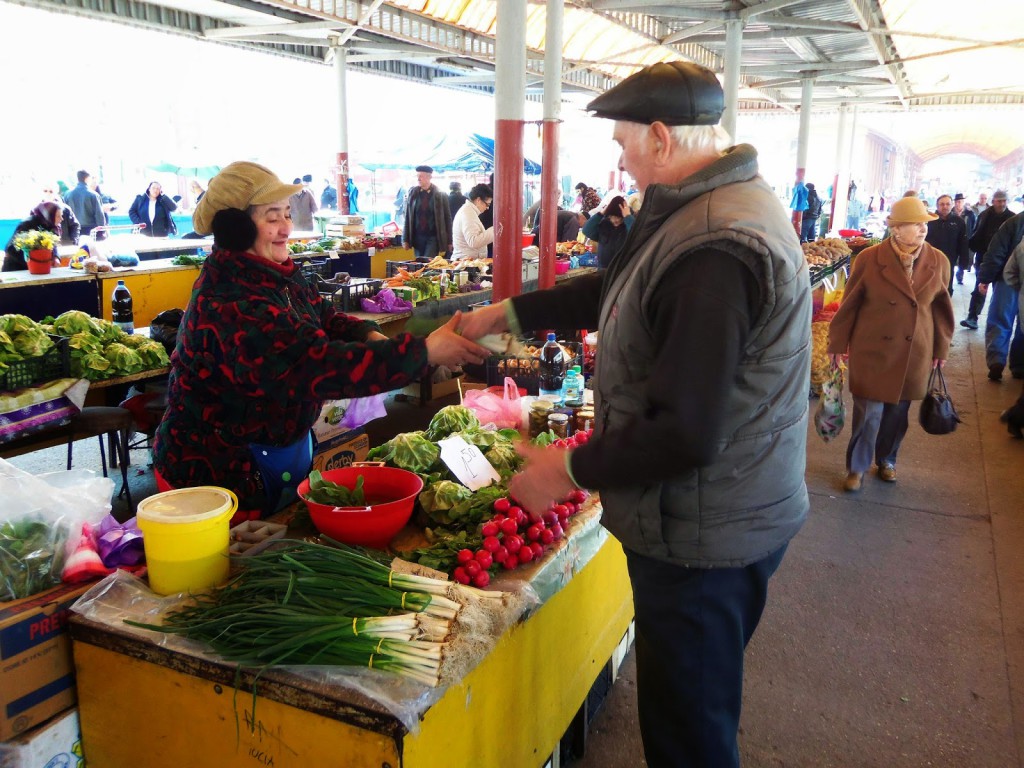
Our society has a troublesome relationship with food. Although we produce enough food to adequately feed all, both obesity and under-nutrition affect an estimated 2.3 billion people globally causing 6 million deaths annually (1-2). Nowadays, many eat poorly to enable others to eat badly and cheaply, while food production has become a major driving force in pushing the environment beyond planetary boundaries. Growing water and food needs due to population growth, climate change, consumption shift towards meat-based diets and biofuel development exacerbate the already critical challenges to planet boundaries and food security and nutrition. If we extrapolate current food consumption and production trends, humanity will need three Earths by 2050 to meet demand. Within that scenario, how feasible is it to eradicate chronic malnutrition, especially if we keep considering food as a commodity? Wouldn’t it be wiser, fairer and more sustainable to consider food as a commons, or a public good that should be governed as a commons, and food and nutrition security as a global public good?
The systemic fault lines of the global food landscape
Food has evolved into a private, transnational, mono-dimensional commodity in a global market of mass consumption. The mechanisms of enclosure, or restriction and privatisation of common resources through legislation, excessive pricing and patents, have obviously played a major role in limiting access to food as a commons. Additionally, the social construct of food as a commodity denies its non-economic attributes in favour of its tradable features, namely durability, external beauty and the standardisation of naturally-diverse food products, leading to a neglect of nutrition-related properties of food, alongside an emphasis on cheap calories.
One has to admit that the industrialisation and commodification of food brought humanity some positive outcomes in the form of increased food production and food access for millions; but it also yielded many negative externalities, namely inequality, inefficiency and unsustainability within planetary boundaries, with the mono-dimensional valuation of food as a commodity the fourth critical negative. The transnational corporations that dominate the industrialised food system are major drivers of malnutrition and environmental degradation by operating to accumulate and under-price calorie-based food resources (3), seeking to maximise the profit of food enterprises instead of maximising the nutrition and health benefits of food to all. Governed by self-interest, private markets will not provide an adequate quantity of public goods, such as health, nutrition and hunger eradication, which have enormous benefits to human beings but are non-monetizable, as the positive externalities cannot be captured by private actors. And, rather crucially, these fault lines will not be reversed or corrected by simply applying a sustainable intensification lip service (4) that mostly addresses the technological challenges and obscures the social and power imbalances.
Multi-dimensional food is crowded out by commodification
The development of food as a pure commodity radically opposes the other dimensions, rather important for our survival, self-identity and community life: food as a basic human need to keep its vital functions (5); food as a pillar of every national culture (6); food as a fundamental human right that should be guaranteed to every citizen (7); and food as a part of a wider ecological context involving sustainable production. All those dimensions enrich the consideration of food as a commons.
Instead, today, these multiple dimensions of food are combined with and superseded by its tradable features, thus conflating value and price (understanding the former in terms of the latter). Under capitalism, the value in use (a biological necessity) is highly dissociated from its value in exchange (price in the market) (8), giving primacy to the latter over the former (9). Food as a pure commodity can be speculated by investors, modified genetically and patented by corporations, or diverted from human consumption just to maximise profit. Nutrition is overshadowed by uses with higher returns to investment (although recent narratives are trying to demonstrate how financially profitable it is to reduce hunger (10)).
The corporate (neoliberal) food regime defines a set of rules institutionalising corporate power in the world food system deepening the commodification of food by radically undermining its non-monetary dimensions (11). Market rules not only put prices to foodstuff, but in doing so markets corrupt their original nature (12). This reduction of the food dimensions to one of a commodity explains the roots of the failure of the global food system (13-14); therefore the most revolutionary and structural shift is to re-value the multiple dimensions of food for human beings, beyond its artificially low price in the market.
Nevertheless, none of the major analyses produced in the last decades on the fault lines of the global food system and the very existence of hunger, has ever questioned the nature of food as a private good (15-19). Recent post-2015 debates and feeding documents maintain the same narrative frame. Despite previous efforts within the UN system (20), neither food and nutrition security is considered as a Global Public Good nor food as a commons.
The re-commonification of food: innovative approaches to historical developments
The re-commonification of food implies a shift in the economic and political narratives around food production, consumption and ethical considerations. Excludability and rivalry, the features used by the modern economic school to define private/public/common goods, are not ontological (absolute) properties of goods; they are social constructs created by human beings. In fact, goods often become private or public as a result of deliberate policy choices. The degree of excludability and rivalry depends upon variables related to the nature of the good, the consumption/utilisation rate, technological developments, and the definition and enforcement of property rights defined by entitlements, regulations and sanctions. Both properties are attributes that human society assigns to different types of goods, largely based on a dominant ideology, particular economic thinking and historical considerations; consequently, they can be modified. Although none of the major analyses produced in the last decades on the fault lines of the global food system and the very existence of hunger has questioned this nature of food as a private good, it is recommended here that the economic consideration of food as a private good be revisited.
In history, food has not always been regarded as a pure commodity devoid of other important dimensions and food commons are not new. Many societies have considered, and still consider, food as a commons, as well as the land and water and its forests and fisheries; and the consideration different civilisations have assigned to food-producing commons is rather diverse and certainly evolving. Well-documented examples of live and functional food-producing commons can be found at both ends of the developmental scale (21). The agricultural and related utility of commons to human societies has enabled them to survive up to the present day, despite the waves of enclosure, misappropriations and legal privatisations.
Crowdsourcing the transition to food as a commons
Over the last 20 years, there have been two streams of civic collective actions for food running in parallel: the food sovereignty movement and the Alternative Food Networks (AFN). These two streams have been exploding in urban and peri-urban areas, presently putting the corporate food regime under increasing scrutiny through innovative counter-hegemonic narratives concerning the major systemic fault lines of inequality, inefficiency, unsustainability and commodification. Although the food sovereignty movement has not yet fine-tuned with legitimate concerns for healthy and local food, natural conservation, and less-polluting forms of food consumption by urban consumers, one can be appreciative of their strategic importance. Food is a powerful weapon for social transformation and the convergence of these two movements is expected to mark a great tectonic movement in the global and national food system governance in the years to come, particularly as they are organisational drivers of change in the transition towards what could be more appropriately termed a food commons regime.
The food commons regime would fundamentally rest on the idea of food as a commons, which means revalorising the different food dimensions that are relevant to human beings and thus, of course, reducing or abolishing altogether the tradable dimension that has rendered it a mere commodity. In fact, thanks to countless progressive democratic movements across the globe, food-related elements are already being considered as global or national commons, and an evolving governance of the food system is being constructed from bottom-up grassroots urban and rural initiatives. Amongst the food-related elements being considered as global or national commons, we can mention: (a) material and non-material food-related elements already considered as commons; (b) edible plants and animals produced by nature; (c) genetic resources for food and agriculture; (d) traditional agricultural knowledge; (e) modern, science-based agricultural knowledge produced by public institutions; (f) cuisine, recipes and national gastronomy; (g) food safety, and; (h) nutrition, including hunger and obesity imbalances.
The food commons regime would inform an essentially democratic food system based on sustainable agricultural practices (agro-ecology) and open-source knowledge (creative commons licenses) through the assumption of relevant knowledge (cuisine recipes, agrarian practices, public research, etc.), material items (seeds, fish stocks, etc.) and abstract entities (transboundary food safety regulations, public nutrition, etc.). Departing from our current regime, this transition entails a move from a state-private sector duopoly to a collective, polycentric and reflexive governance of food, where the third pillar would be the self-regulated, civic, collective actions for food that are now emerging all over the world. In short, a food commons regime would be governed in a polycentric manner by food citizens (22) that develop food democracies (23-24) which value the different dimensions of food (25).
Quite relevant for the post-2015 debates and final agreement, the transition towards a food commons regime and a Zero Hunger scenario will need a different kind of state, a partner state, with different duties and skills to steer that transition. The desirable functions are shaped by partnering and innovation rather than command-and-control. Public authorities will need to play a leading role in support of existing rural and urban commons, and the creation of new commons for their societal value. The challenge for the private sector in the process of transitioning out of the current economy, is to be driven by a different ethos: keeping, indeed, an entrepreneurial spirit but focused on social aims and satisfying needs. Agro-ecology, family farming and more socially-embedded forms of production such as co-operatives and social enterprises are examples of this. In that sense, by limiting the influence of market provision and encouraging (politically and financially) the development of other modes of food provision (state or communal), we can re-build a more balanced tricentric food system.
Food Commons as a transformational narrative
Unlike the market, the food commons are about equity, collectiveness, embeddedness and direct democracy from local to global. This invokes a radical paradigm shift from individual competitiveness and selfish rationality – the motivational drivers of “progress” via endless growth in the current political-economy – towards collective cooperation and the other’s regard, key drivers of happiness and the common good. We need to develop a food system that first, provides for sustainable nutrition for all and second, provides meaning and not just utility to food production, trading and consumption. The re-commoning of food will open up the transition towards a new food regime in which primacy rests in the irreducible needs of human beings (nutrition + culture + community), and in the different dimensions of food.
But re-commoning is just an idea; an alternative narrative that will have to fight against the productivist and consumerist paradigms so hegemonic in world politics and people’s minds these days. Changes in societies are mostly driven by a clash of paradigms and a constant renewal of social constructs and value frames. Let’s make “food as a commons” a subversive meme (an element of the counter-hegemonic culture that replicates, mutates and spreads from one civic food action to another) to substantiate the transformational narrative to confront the dominant mainstream discourse of “food as a commodity”. Let’s make commons food common. Let’s commonify the commodity, to eradicate hunger in the post-2015 scenario.
This article first appeared on the Hearthwood Institute and Press website.
Heathwood Institute and Press is a non-profit, critical theoretical organisation that was formed by a collective of academic researchers across a wide range of disciplines.
Motivated and inspired by Frankfurt School critical theory, our aim is to investigate the root causes of social, economic and environmental inequality by offering foundational, holisitic social critique as well as promoting concrete, critical alternatives to the type of social policy symptomatic of today’s highly unjust societies.
Bibliography
(1) Black, R.E., C.G. Victora, S.P. Walker, Z.A. Bhutta, P. Christian, M. de Onis, M. Ezzati, S. Grantham-McGregor, J. Katz, R. Martorell, R. Uauy, and the Maternal and Child Nutrition Study Group. 2013. Maternal and child undernutrition and overweight in low-income and middle-income countries. The Lancet 382 (9890): 427-451.
(2) Ng, M. et al. 2014. Global, regional, and national prevalence of overweight and obesity in children and adults during 1980–2013: a systematic analysis for the Global Burden of Disease Study 2013. The Lancet 384 (9945): 766–781.
(3) Monteiro C.A., R.B. Levy, R.M. Claro, I.R. de Castro and G. Cannon (2011). Increasing consumption of ultra-processed foods and likely impact on human health: evidence from Brazil. Public Health Nutr. 14 (1): 5-13.
(4) Godfray H.C.J. and T. Garnett (2014). Food security and sustainable intensification. Phil. Trans. R. Soc. B. 369: 20120273.
(5) Max-Neef, M. 1992. Development and human needs. In P. Ekins, M. Max-Neef, eds. Real-life economics–understanding wealth creation. Pp. 197–213. Routledge, London.
(6) Montanori, M. (2006). Food is culture. Arts and traditions on the table. New York: Columbia University Press.
(7) United Nations (1966). International covenant on economic, social and cultural rights, adopted on 16 December 1966, General Assembly Resolution 2200(XXII), UN. GAOR, 21st sess., Supp. No. 16, U.S. Doc. A/6316 (1966), 993 UNTS 3.
(8) Timmer, P., W.P. Falcon and S.R. Pearson (1983). Food policy analysis. Washington, D.C.: Johns Hopkins University Press.
(9) McMichael, P. (2009). A food regime genealogy. Journal of Peasant Studies 36 (1): 139-169.
(10) IFPRI (2014). Global Nutrition Report 2014: Actions and Accountability to Accelerate the World’s Progress on Nutrition. Washington, DC: International Food Policy Research Institute, 2014.
(11) Pechlaner, G. and G. Otero (2010). The neoliberal food regime: neoregulation and the new division of labor in North America. Rural Sociology 75 (2): 179-208.
(12) Sandel, M.J. (2012). What isn’t for sale? The Atlantic, Feb. 2012. http://www.theatlantic.com/magazine/archive/2012/04/what-isnt-for-sale/308902/
(13) Magdoff, F. and B. Tokar, eds. (2010). Agriculture and food in crisis. Conflict, resistance, and renewal. New York: Monthly Review Press.
(14) Zerbe, N. (2009). Setting the global dinner table. Exploring the limits of the marketization of food security. In: J. Clapp and M.J. Cohen, eds. The global food crisis. Governance challenges and opportunities. Ontario: The Centre for International Governance Innovation & Wilfrid Laurier University Press.
(15) FAO (2012). The future we want. End hunger and make the transition to sustainable agricultural and food systems. Rome: FAO.
(16) UK Government (2011). The future of food and farming: challenges and choices for global sustainability. Final project report. London: Foresight, Department for Business Innovation and Skills. The Government Office for Science.
(17) United Nations (2012). The Future we want. A/RES/66/288. United Nations Conference on Sustainable Development, Rio de Janeiro, June 2012. September 2012. https://sustainabledevelopment.un.org/futurewewant.html
(18) World Bank (2008). World development report 2008: agriculture for development. Washington, DC: World Bank.
(19) WEF (2013). Achieving the new vision for agriculture. New models for action. Davos: The World Economic Forum.
(20) Kaul, I., P. Conceição, K. Le Goulven and R.U. Mendoza, eds. (2003). Providing Global public goods: managing globalization. New York: Oxford University Press.
(21) Vivero, J.L. (2014). Transition Towards a Food Commons Regime: Re-Commoning Food to Crowd-Feed the World. SSRN Working paper. http://papers.ssrn.com/sol3/papers.cfm?abstract_id=2548928
(22) Gomez-Benito, C. and C. Lozano (2014). Constructing food citizenship: theoretical premises and social practices. Italian Sociological Review 4 (2): 135-156.
(23) Lang, T. (2003). Towards a food democracy. In S. Griffiths and J. Wallace, eds. Consuming passions: food in the age of anxiety. Pp. 13-24. Manchester: Manchester University Press.
(24) De Schutter, O. (2014). The transformative potential of the right to food. Report of the Special Rapporteur on the right to food to the UN Human Rights Council, A/HRC/25/57.
(25) Vivero, J.L. (2013). Food as a commons: reframing the narrative of the food system. SSRN Working paper series http://papers.ssrn.com/sol3/papers.cfm?abstract_id=2255447
* Jose Luis Vivero Pol is a PhD candidate on food governance. BIOGOV Unit, Centre for Philosophy of Law, Université catholique de Louvain. http://biogov.uclouvain.be
Email: Jose-luis.viveropol@uclouvain.be
This article is a summarized version of a working paper that can be downloaded at:http://papers.ssrn.com/sol3/papers.cfm?abstract_id=2548928




